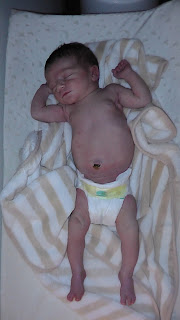Before having a child of my own, when picturing my future baby, I always imagined a rosy cheeked little cherub child. But anyone who has been around a newborn knows that most babies are not born that way. We all know they tend to look "scrunchy," swollen, and pink… but there are many other features that are common in new babies- some of which may be surprising to new parents!
 Cone/Large Head: Newborn skull bones are soft and aren't fused together yet in order to accommodate birth and the growing brain. Cone heads are common and are usually caused when the baby is stuck in the birth canal for too long. Luckily, the head will usually round back out again after a few days. All babies' heads are large in comparison to their bodies because their brains are much further developed than their bodies at birth.
Cone/Large Head: Newborn skull bones are soft and aren't fused together yet in order to accommodate birth and the growing brain. Cone heads are common and are usually caused when the baby is stuck in the birth canal for too long. Luckily, the head will usually round back out again after a few days. All babies' heads are large in comparison to their bodies because their brains are much further developed than their bodies at birth. Body Hair: Some babies are born with fine hair all over their body called Lanugo. This hair forms in the womb to keep babies warm before they are fully developed and usually disappears before birth. For this reason, lanugo hair is usually found on premature babies. It will disappear within a few days or weeks.
Body Hair: Some babies are born with fine hair all over their body called Lanugo. This hair forms in the womb to keep babies warm before they are fully developed and usually disappears before birth. For this reason, lanugo hair is usually found on premature babies. It will disappear within a few days or weeks.Disfigured Body/Belly: The legs and arms of a newborn are not surprisingly, usually bent and bowed from spending all that time in the womb. They will stretch out soon enough. A baby belly will usually resemble a bloated frog, then will become more Buddha-shaped after a few months.
White Substance on Skin: Many babies will be born with Vernix Caseosa, a white, cheesy/waxy substance on their skin. This is perfectly healthy and can simply be wiped off or rubbed into the baby's skin as a moisturizer.
Soft Spots: All babies have two soft spots on their heads, called Fontanels, located on top of the head at the front, and one in the back under the crown. These are the places where the skull bones aren't yet fused together in order to allow for birth and for the brain to continue growing. They are okay to touch gently, and they will typically stay around for the first year or two of life.
Discolored/Splotchy Skin: Most babies are born a purplish/red color, then will turn pinker over a few hours. Some babies will develop jaundice and as a result will take on a yellow skin tone. Some may have red patches above the hairline at the back of the neck, on the eyelids or between the eyes. These may fade with time or become less noticeable. Dark-skinned babies are often born with a large gray mark on the bottom or lower back called Dermal Melanosis, which also goes away after a few weeks or months. Little white spots may be found on the face or other areas of the body called Milia. These, too, will usually fade with time.

Swollen Face/Genitalia: At birth, newborn bodies are full of hormones from their mothers and fluids from the womb. A result of this are swollen body parts, including the eyes, nose, nipples and genitalia.
Baby Girl "Period": Strange as it sounds, baby girls may have a mini "period" after birth or some vaginal discharge. This is the result of the baby flushing out mother's hormones and is nothing to be concerned about.
 Smelly Umbilical Cord: The umbilical cord will usually fall off within the first two weeks, but before it does, it might start to take on a strange smell. Nothing needs to be done with it- it will fall off soon!
Smelly Umbilical Cord: The umbilical cord will usually fall off within the first two weeks, but before it does, it might start to take on a strange smell. Nothing needs to be done with it- it will fall off soon!Eye Color: A baby's eye color is never certain right after birth. Many are born with blue or gray eyes that change after a few months; others acquire their true color right away. They could take years to reveal their true form (but as we all know, eyes can even change in adulthood!) But by 6-9 months of age, a baby's eyes will probably remain the way they are.
Baby Acne: These small red bumps appear after a couple of weeks after birth and will usually go away on their own after another few weeks. This, too, is caused by the flushing out of mom's hormones from the baby's body.
 Hair Loss: If your baby is born with hair, he/she may keep it, or lose it over the next few months. A bald spot may form where the head rubs against surfaces (the back of the head is a common spot). The hair may not grow back in until 6 months of age or later.
Hair Loss: If your baby is born with hair, he/she may keep it, or lose it over the next few months. A bald spot may form where the head rubs against surfaces (the back of the head is a common spot). The hair may not grow back in until 6 months of age or later.
No comments:
Post a Comment
Thank you for reading our blog. Once your comment is approved it will post to the site.